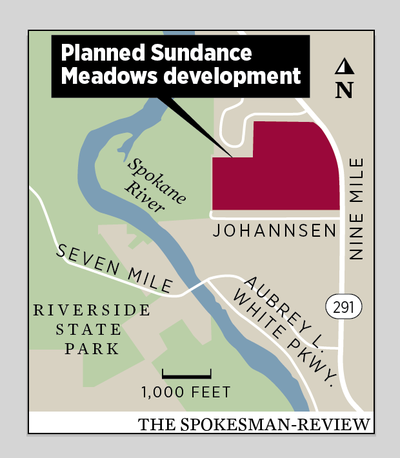Hearing set for 475-home redevelopment of Sun Dance golf course

Holly Higens isn’t aiming to prevent the shuttered Sun Dance Golf Course from becoming a residential community, she said. She’s pushing the county to reevaluate the developer’s plan, look more closely at its environmental impact and perhaps cut back the scale of its ambition.
If Sundance Meadows LLC has its way, the fairways and greens that have spanned the 88-acre parcel for a half-century will become the site of a 475-home subdivision set between Nine Mile Road and the Spokane River – and right behind Higens’ backyard.
“We’d like to be able to lessen the footprint and to have a development that can fall in line with the resources that the area has,” Higens said.
While the county has already issued a permit for the developer to begin grading the land, the group Shape Our Highway 291, which refers to the official name of Nine Mile Road and to which Higens belongs, has appealed the county’s environmental assessment of both that permit and of the subdivision’s preliminary plat.
The county has issued what is known as a mitigated determination of nonsignificance for both the grading permit and the plat.
Such a determination is issued when officials identify development impacts and require the inclusion of “elements that would help mitigate” those impacts, according to Tammy Jones, principal planner for Spokane County.
In the case of Sundance Meadows, as the development will be known, the developer will be required to add a shared-use path along Nine Mile Road; construct a new roundabout at Seven Mile and Nine Mile roads; improve Nine Mile Road’s intersections with Francis Avenue, Driscoll Boulevard and Assembly Street; and construct a lift station to connect the subdivision to the city sewer system.
The request for those improvements came as a result of feedback from not only neighbors like Higens but from the city of Spokane and the Washington State Department of Transportation, among other agencies and jurisdictions.
Although the development would help meet the region’s rapidly growing demand for housing, neighbors have continued to express concerns about the development’s impact on traffic, schools and the environment and have been pushing back on the plan since soon after the initial permit applications were filed in April 2019.
The county’s hearing examiner is tasked with making final determinations about the grading permit, the plat and the appeals before the project can move forward toward construction.
Last week, the hearing examiner held an online meeting ahead of his decision.
It drew so much interest that it ran for eight hours and had to be continued. As a result, a second meeting about the proposed plat and the appeal to it is slated for Wednesday, beginning at 9 a.m.
But Higens said she has lingering concerns about the development and wants the county to perform a more comprehensive Environmental Impact Study to look at the project “holistically,” rather than issuing separate determinations for each of the project’s various elements.
She is concerned about a number of issues, including the fate of the course’s stock of trees, the density of the planned housing, traffic congestion, the connection between the development and Riverside State Park, and the potential presence of elevated levels of arsenic and mercury on the land.
Those concerns about toxins are not unwarranted, documents suggest.
A consultant enlisted by the developer to conduct an environmental review of the site has sampled the site for various heavy metals and contaminants, in part at the request of concerned neighbors.
“Comments provided by the community identified the potential for elevated arsenic presence in site soils associated with select agricultural chemicals sometimes associated with golf course maintenance,” according to a Jan. 18 letter from Fulcrum Environmental Consulting to the county. “In review of the provided information, Fulcrum found the concern credible and recommended soil testing of representative greens, tee boxes, and fairways.”
Based on reviewed information, Fulcrum recommended the sampling be extended beyond arsenic to include lead and mercury.
While the consultant did not detect the presence of significant arsenic or lead on the site, it did find mercury “above the regulatory levels” on two putting greens, according to Fulcrum’s January letter. Further testing indicated four other greens also contained mercury contamination.
But digging deeper, Fulcrum didn’t find widespread toxins.
“Only one location was identified with mercury contamination at 6 inches, indicating that the residual mercury impact is constrained to localized areas of near surface soil,” the letter reads.
Ultimately, the firm recommended “six localized areas of near surface mercury impacted soil be addressed in accordance with applicable environmental and worker protection regulations prior to, or at the start of, redevelopment activities.”
Higens, however, believes Fulcrum’s findings warrant further investigation to ensure the safety of existing and future residents. She would like to see that happen as part of a broader environmental review before work proceeds.
Meanwhile, the developer is designing the required sewer lift station and aims “to start final engineering, when the project is approved,” according to Todd Whipple, president of Whipple Consulting Engineers Inc., which is helping design the development.
The developer has already funded traffic studies of the project, Whipple said.